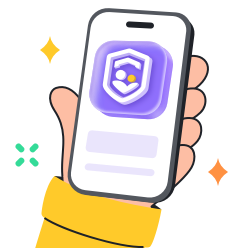Nowadays, engagement with screen media is at its peak, and you may be surprised to know that 50.4% of teens ages 12–17 spend more than 4 hours daily in front of screens, according to the survey of the National Center for Health Statistics. Such excess screen engagement affects them mentally and physically and negatively impacts their studies as well. So, there is a need to control your children’s screen time. Don’t worry; the iPhone Screen Time feature will help you monitor and limit your kids’ phone usage.
Let us see how this feature can be set up on your kid’s device. Moreover, this blog will also discuss FlashGet Kids as an alternative for advanced monitoring of kids’ online activities. So continue reading!
Why is screen time management critical for kids?
The average screen time for teenagers has increased year over year for almost a decade. With excessive use of mobile devices and social media, it becomes necessary for parents to take strategic measures to limit screen time. Let’s discuss why you have to manage your kid’s phone usage.
Screens emit blue light, and exposure to it at night has an adverse effect on melatonin, a brain chemical that regulates sleep. The result is that children don’t get enough sleep, and with that comes fatigue, crankiness, anxiety, and distraction.
Another problem is that screen time can also have direct effects on physical health. Longer screen time is associated with an increased risk of obesity in adolescents, particularly when combined with less outdoor activity.
Meanwhile, children can easily get caught up in the virtual world, neglecting physical activities, isolating themselves from families and peers in real life. These have several detrimental effects on their communication and social skills development.
Excessive screen use is linked to emotional health, sleep disturbances, social skills issues, and declining academic performance. Therefore, it recommends limiting screen time for teens to no more than 14 hours per week to mitigate negative impacts and promote other healthy outdoor activities.
Get your child into healthy screen habits with open talks and extra protection.
What is Screen Time on an iPhone?
Screen Time is a set of built-in settings on iOS devices that helps parents to monitor and manage the time their kids spend and the activities undertaken on the devices. This functionality is very important and specific to parents who want to manage their children’s screen use.
Screen Time is enabled by default for all iOS devices linked with a particular Apple ID. For kids’ iPhone, iPad, or Mac, the Screen Time features immediately collect information on the usage statistics, limit certain activities, and prioritize all the connected devices.
Key functions:
- Downtime: This feature is normally set when you do not want to use the screen. It allows only specific apps and phone calls.
- App limits: This feature makes it possible to limit the time allocated for the usage of applications. Once the specified threshold is attained, the application will be permanently locked for the rest of the hours.
- Communication restrictions: You can set an age restriction for who your child can contact during the day and downtime so they stay in touch with the right people. Thus, all these features help kids enjoy healthy mobile usage.
- View activity reports analytics: You can check the details of what apps and websites they visit or how often your families visit.
- Content & privacy restrictions: This feature offers privacy protection by limiting such options as in-app purchases, violent content, pornographic elements, and so much more.
How to set up Screen Time on iPhone for kids?
Are you interested in applying iPhone screen limit management to better control and manage your child’s phone usage? Okay! But before setting iPhone screen time limit, enable the following factors:
- Updated Software: To set up restrictions on screen time, the child’s device should use the most current iOS.
- Apple Family Sharing: Family Sharing needs to have been set up. The reason is that it allows you to control your child’s phone usage from your own phone.
Enable Family Sharing
Steps to Family Sharing
- Launch Settings on your iPhone. You’ll see Apple ID on the upper portion of the screen. Just click on the link.
- Under the Apple ID section, choose Family Sharing and then click on Screen Time under the More to Share section.
- Finally, select the “Create an Account for a Child” option. That’s it!
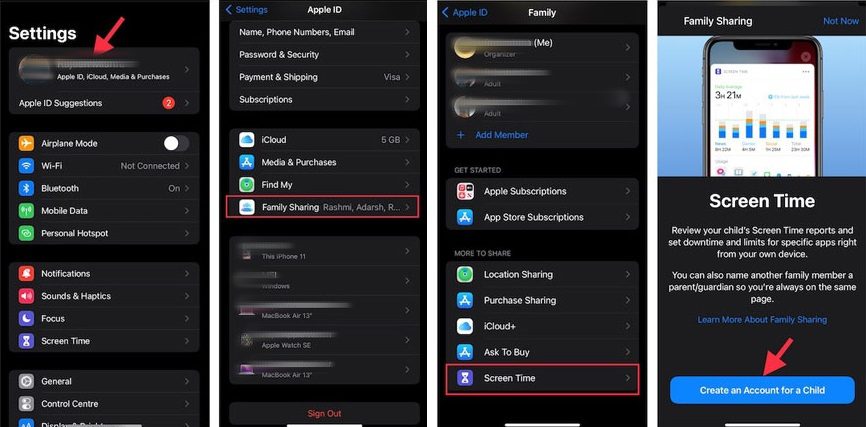


Turn on Screen time for kid’s iPhone
While enabling Screen Time, the very first thing that any user has to do is create an account for children, which has been discussed in the previous section. After this, you can now easily configure and apply an iPhone screen time limit by following the guidelines.
Now, you are already in a family group.
Steps to enable Screen Time on kid’s iPhone
- Access Settings on your iPhone > Screen Time.
- You can also set up the Screen Time settings on your child’s iPhone directly.
- Settings > Turn on Screen Time > Continue > This is My Child’s iPhone
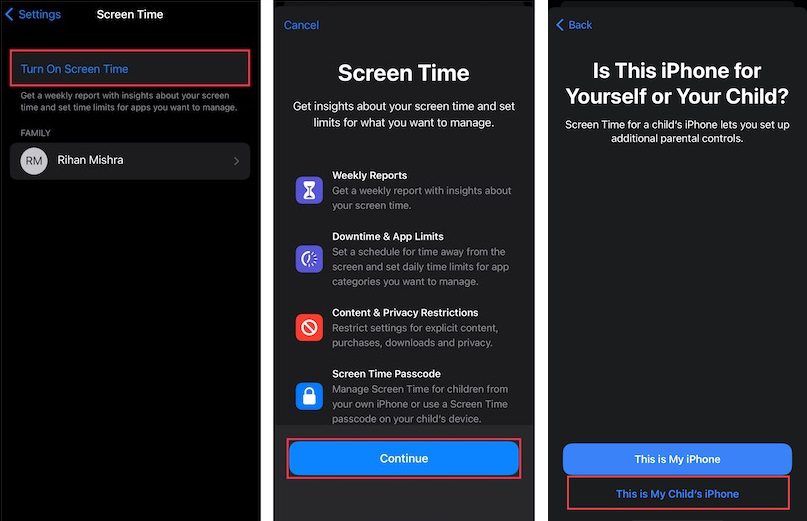


That’s it! After this, you can combine all its options, such as App Limits, Downtime, and Content & Privacy Restrictions on your child’s iPhone.
Lock Screen Time Settings
Now, after activating the screen time, you have to lock the settings by generating a passcode so that your kids cannot alter those features.
Steps to lock Screen Time settings for kids
- Access Screen Time, scroll down to tap the ‘Use Screen Time Passcode” option.
- Create a strong passcode. Confirm the passcode by entering it again.
- After this, you are required to enter an Apple ID so that the passcode can be retrieved if it has gone missing.
Thus, by following the steps mentioned above, you can prevent your kids from changing the settings that you have made on their phones to limit their screen time.
Advanced Screen Time limits on kids’ iPhone
You may also set advanced Screen Time limits to control kids’ apps, websites, and communication. So, here we’ll share a detailed guide on setups for your kid’s iPhone. So, keep scrolling!
Downtime hours
- Step 1. Click on the child’s name under the option ‘family’.
- Step 2. Choose the Downtime option, turn on Schedule, and set a schedule for only those with allowed apps.
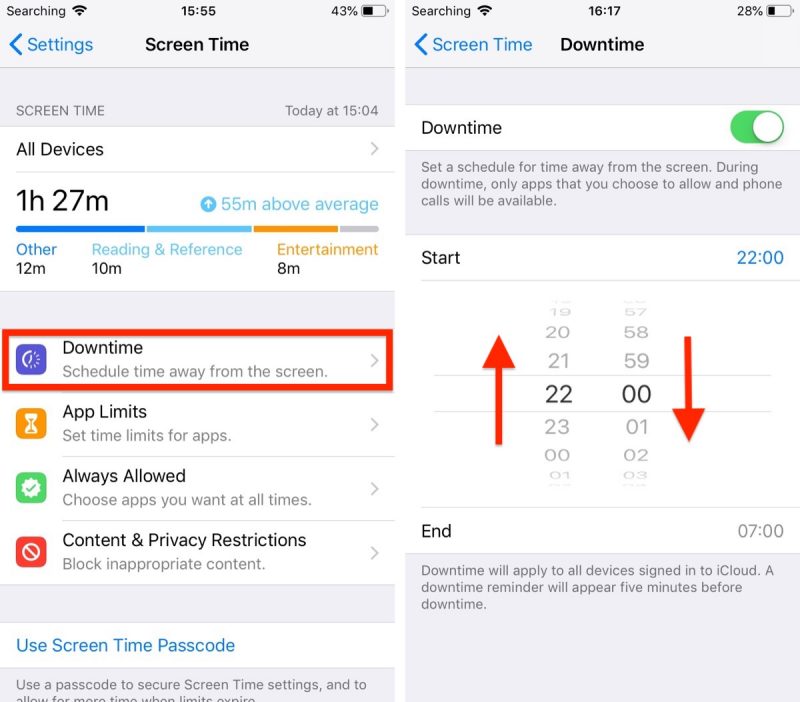


App limits
- Step 1. Screen Time > App Limits > Add Limit, to set a daily time limit on the chosen apps.
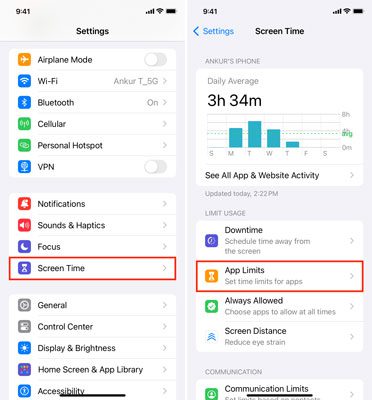


- Step 2. You will see the all apps or categories option under the Choose apps section. You can also select a group of apps, such as Social, Games, or Entertainment.
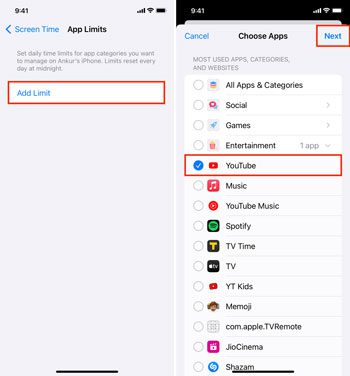


- Step 3. You can set a time limit on desired apps as you wish. That’s it!
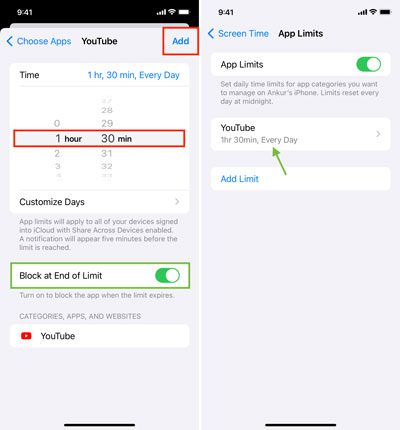


Content & Privacy Restrictions
- Step 1. Scroll to Content & Privacy Restrictions, and then turn it on.
- Step 2. Users can now restrict purchases on the iTunes Store and the App Store, and can set other content restrictions, such as movies, music, and websites.
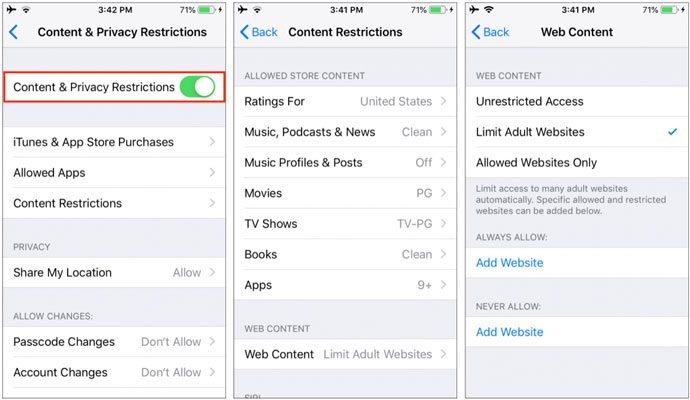


Communication Limits
- Step 1. Screen Time > Communication Limits > you will be asked “whether you are allowed “During Downtime” or “During Allowed Screen Time.” So, go for one that fits your needs.
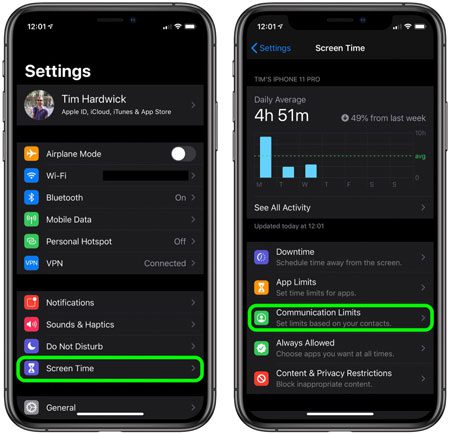


- Step 2. Manage who your kids are allowed to communicate with. Choose either “Everyone” or “My Contacts”.
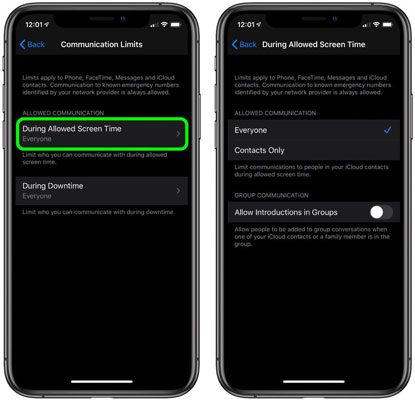


Limitations of Apple Screen Time
The Apple Screen Time function is indeed a very useful assistive feature that helps to control the usage of the devices. However, there are certain factors that would render this less effective in keeping kids’ online safety all around. So, let’s discuss these limitations:
Issues across devices:
Screen Time has been criticized for its need to improve the provided features on iOS devices as the most aggravating concern. Occasionally, Screen Time settings may not sync perfectly across all Apple devices in the family group. Moreover, it is not available between iPhone and Android devices.
No notifications for rule breaks:
The most highlighted limitation of screen time is that it does not notify parents about bypassing rules in real time. As a result, parents are informed about these bypassing activities only when they see the reports.
Bypassing Screen Time limit:
Tech-savvy children may find ways to bypass restrictions even you have a Screen Time password, such as changing device settings or using third-party apps.
FlashGet Kids: Additional management and monitoring for kids
While iPhone Screen Time is great for basic limit and protection, third-party parental control apps like FlashGet Kids provide more comprehensive features that expose core controls, monitoring, and actions for kids. Let’s compare both tools for quick decisions.
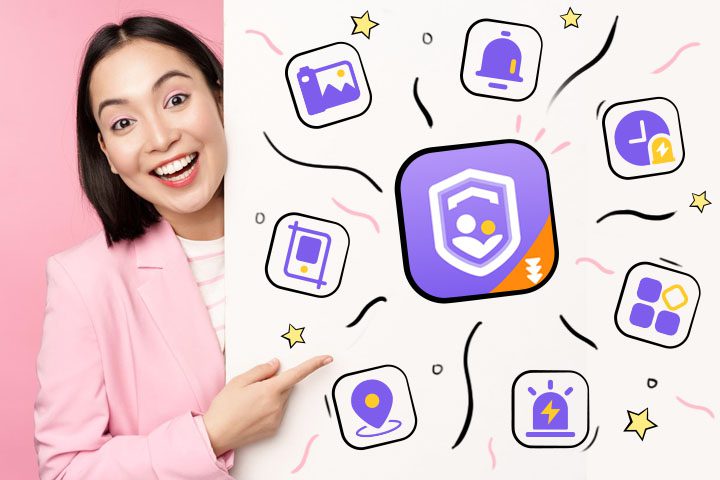


iPhone Screen Time vs. FlashGet Kids
| Features | iPhone Screen Time | FlashGet Kids |
| Compatibility | Only iOS devices | iOS & Android devices |
| App monitoring | Provide basic reports on child’s app usage | Provides real-time app usage statistics |
| Content filtering | Restrictions on basic sites and for some set applications | Provides filtering of apps and websites with customized keyword detection and safe browsing |
| Location tracking | X | Real-time location tracking + Geofencing |
| Communication limits | Provides basic limitations | X |
| Screen time management | Provides app limits and downtime functions. | Provides full customizable screen time limits |
| Remote camera & microphone access | X | One-way audio and remote camera |
| Additional features | No | One-in-all app |
| Ease of use | Easy, built-in setting | Moderate – Requires app installation and setup |
| Bypass resistance | Low, only a passcode | High – With stealth mode |
| Pricing | Free | Paid |
Thus, the iPhone Screen Time feature is more advantageous for iOS users who want basic management and content restrictions. On the other hand, FlashGet Kids is more advanced parental control software for Android and iOS systems. This program places a more sophisticated ceiling on kids when they interact with the gadgets.
For that reason, such an option should be adopted so as to provide more safety to the children when using the internet, rather than just providing screen time restrictions. Let us now look into the specifics of FlashGet Kids to see which other advantages this application has for children’s safety.
A quick glance at FlashGet Kids
“FlashGet Kids is the ideal ‘one-stop’ application for parents to provide their kids a healthy digital room by managing their digital activities.”
FlashGet Kids incorporates multiple features that enhance the safety of children while online and offline. There are easy-to-follow steps to start using it.
- Using the screen-mirroring option, parents can keep track of their children’s activities in real-time and see whether they have opened inappropriate apps or websites or talked with someone.
- In addition, the GPS tracking feature comes with a geofencing capability that sends alerts to parents immediately if kids move out of a certain location.
- Lastly, the biggest advantage that parents enjoy is that they can set explicit content keywords themselves. So, in case children enter any of these words in any content they access, such content won’t be displayed in front of the children.
Final takeaways
Setting the iPhone screen time limit for kids is a critical part of managing their digital health. Screen Time offers many essential features for parents who want basic control over their kids’ online activities. However, parents seeking a way to enhance their kids’ online security must install FlashGet Kids. It provides a one-stop solution, from limiting screen time to tracking a child’s live location, thereby helping to keep kids safe online and offline.
FAQs
You can choose either the built-in Screen Time feature or an application like FlashGet Kids, which can accurately monitor the child’s Screen Time. However, you can go for Flashget Kids if you want advanced monitoring of kids’ offline and online activities.
No, the iPhone Screen Time does not in any way contribute to battery life. Screen Time is a simple add-on for monitoring and restricting gadget usage with minimal impact on system resources. On the other hand, if the gadget is spent on activities connected to screen time, the battery could also be spent more quickly. Thus, it indirectly affects the battery life.
Whenever the set-up screen time limit for the use of the app, or any type of content, is reached, your child will receive a notification that says: “You have exceeded the usage limits.”Moreover, he or she will not be able to access the application until either the threshold has reset or the preferences have been modified.

